Hot Weather Threatens U.S. Winter-Wheat Crop in Southern Plains
Category: Grains, Miscellaneous, Oilseeds
 (Bloomberg) – Deteriorating crop conditions for U.S. winter wheat probably will worsen over the next 10 days as hot, dry weather compounds damage from last year’s drought and freezes over the past six weeks, forecasters said.
(Bloomberg) – Deteriorating crop conditions for U.S. winter wheat probably will worsen over the next 10 days as hot, dry weather compounds damage from last year’s drought and freezes over the past six weeks, forecasters said.
Above-normal temperatures and limited precipitation in western counties of Kansas, Oklahoma and Texas and in eastern Colorado will add stress to crops already expected to yield less than last year, Joel Burgio, a DTN meteorologist in Lexington, Massachusetts, said in a report yesterday. About 31 percent of winter-wheat fields were in good or excellent condition on May 19, the worst for this time of year since 2006, the government said yesterday.
“We’re going to see more damage to the crop” if the weather is as hot and dry as forecasters predict, Mike Schulte, the executive director of the Oklahoma Wheat Commission, said in a telephone interview from Oklahoma City. “Without moisture, it could cook the plants.”
While prices tumbled this year on signs of rising global output, conditions are worsening in the U.S., the world’s largest exporter. Production will drop 18 percent in Kansas, the biggest U.S. grower of winter wheat, according to estimates from the Wheat Quality Council’s annual tour of the state earlier this month. In Oklahoma, output will plunge 45 percent, according to the state’s grain and feed association.
Wheat futures on the Kansas City Board of Trade have tumbled 11 percent this year to $7.3775 a bushel today. On the Chicago Board of Trade, wheat futures are down 13 percent at $6.77 a bushel.
Winter Wheat
About 73 percent of the wheat produced in the U.S. is the winter variety, which is planted in October and November, goes dormant during the coldest months, and then resumes growth in March and April before the harvest in June.
Thunderstorms from central Oklahoma through north Texas spawned tornadoes yesterday that killed at least 24 people in the suburb of Moore, Oklahoma. More deaths are expected as rescuers sift through debris left by the tornado that was 2 miles (3.2 kilometers) wide.
Temperatures today will top 90 degrees Fahrenheit (32.2 Celsius) in north Texas and are expected to reach 93 degrees in Guymon, Oklahoma, in the panhandle of the state, by May 25, according to the National Weather Service. Hail last week may have curbed yields in parts of north-central Oklahoma, where farmers probably won’t start harvesting until about June 7, two weeks later than normal, Schulte said.
Last year’s drought, the worst since the Dust Bowl era, left winter-wheat fields in November in the worst condition since at least 1985, when the government started keeping records. The Oklahoma crop was rated 19 percent good or excellent, down from 21 percent the prior week, the U.S. Department of Agriculture said yesterday. Kansas was at 28 percent, unchanged from a week earlier.
‘Really Bad’
“If we get more heat, we’ll see even the good wheat start to go bad,” Mike O’Dea, a risk-management consultant at INTL FCStone in Kansas City who forecast the Oklahoma wheat crop at 110 million bushels, said by telephone. “Where there’s good wheat, there’s good wheat, but where it’s bad, it’s really bad.”
Little or no rain has fallen in parts of southwest Kansas, areas in southeast Colorado and the Oklahoma and Texas panhandles in the past month, National Weather Service data show. The region is in an exceptional drought, meaning crop losses have been widespread, while other areas are in extreme drought, meaning losses are imminent, accord to the U.S. Drought Monitor.
Evaporating Moisture
Temperatures will remain high all next week, further drying soils that are already short on moisture, Drew Lerner, the president of Kansas City-based World Weather Inc., said by telephone. Any rain will quickly evaporate because of the hot weather, he said.
“Some of these guys are really hurting,” Lerner said. “Colorado has really been taking it rough the last two or maybe three years. They don’t have much moisture below the surface, so they don’t have the water supply to support anything. We expect to see the continuation of this seasonal warming pattern, and there’s not enough moisture in the ground to help this crop.”




